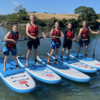Stand-Up Paddling And Kids
Stand-up paddling is extremely fun for kids and a fantastic way to introduce cross training while having fun out on the water.
If your child is is natural to sport or not, stand-up paddling is enjoyed by children of all ages as it benefits from being extremely fun, and by paddling a SUP works on the child’s balance, coordination, fitness level and confidence
We have a range of SUP boards here at Harlyn Surf School from Inflatable to hard board SUPs that are ideal for kids because they are lightweight, easy to carry and a little softer, which helps soften the landing for falls.
We offer a range of SUP lessons for kids and this can be a great way to get some proper instruction and build their confidence to go out on their own.
However if you are an experienced stand-up paddler you can always take your child out with you on the same board to get them comfortable.
You know best and some kids will head out solo the first time, others will need to work up to it.
We spend time building confidence and holding the board steady for your child and encouraging them to kneel over the center of the board. The kneeling position gives you the feel of the SUP and at the same time will feel more stable.
Once comfortable with this, encourage them to try standing up slowly. If not, all they need to do is kneel back down. If you can, find very calm water to introduce them to the sport to build confidence.
As a new skill it does require some practice, but once they are comfortable they should then learn the basics fairly quickly.
The Basic
Once your child is feeling confident and standing up, then they can practice a few basic moves such as:
- turning
- accelerating and decelerating
- falling and jumping off the board
- getting back on the board in deep water
Paddling on a calm water will be a wholly different experience to paddling in the sea, but learning the necessary skills should still be learned no matter the environment.
Having the confidence to not only paddle the board but to get on and off the board in the water will make them feel far more comfortable and safe.
Safety Tips
1. Have a spotter. Its a good idea to either have an adult in the water or on a board close to the child. The spotter can make sure that everyone is paying attention and comfortable.
If you are on your own board stay close to the child. Bringing along a rope or tow line is a great idea, should your child get tired or scared, you can tow them back to shore.
2. Start on flat calm water. Choose a location that has calm water and is not too busy. This will not only help keep the board more stable but there will be less distractions as well.
3. A board leash are essential. The leash will attach to the childs ankle and to the board, so If they should fall or jump in, the leash will make sure they do not lose their board.
4. Make sure the paddle fits their size. A paddle that is too long or that has a shaft that is too big will be much more difficult for a child to use as well as quite heavy. There are several great SUP paddles for kids available. Check out the following for height measurements http://www.grom-sup.com/
An adjustable paddle is ideal as you can lengthen it as your child grows..
5. Remember sun block. The reflection off the water can cause some very serious and quick burns.
The benefits of Stand Up Paddle Boarding (SUP)
One of the things we love about stand-up paddling is that it requires the practice of quite a few skills while still providing an extreme amount of fun.
Many kids who compete in other sports are finding that stand-up paddling is improving their overall athletic skill level.
The reason is because stand-up paddling provides a cross training that helps to improve balance, coordination, endurance, as well as improve overall strength.
Even if you are not paddling, simply standing on the board works on your balance skills.
When paddling all the muscle groups are engaged. The legs are almost always slightly bent and the shoulders, upper back, chest, arms and core muscles must all work together in order to move and control the board.
The coordination required to not only stand but to paddle and turn at the same time is helpful with many other sporting activities.
Kids who have accomplished the sport of stand-up paddling tend to have a better overall body awareness and more fine tuned athletic capabilities.
However the best part is that because it is so much fun, it doesn’t feel like work. Your child does not have to be athletically inclined to enjoy and succeed at stand-up paddling but their skills will be improved upon without them even realizing it.







